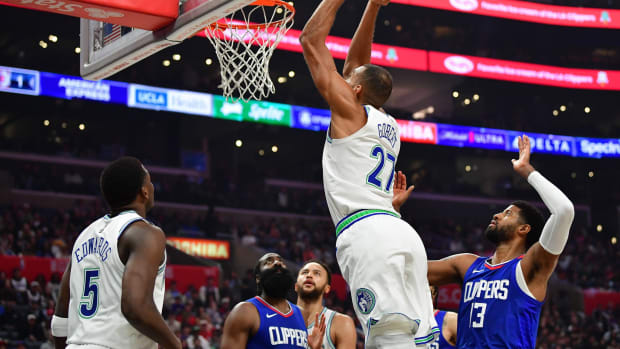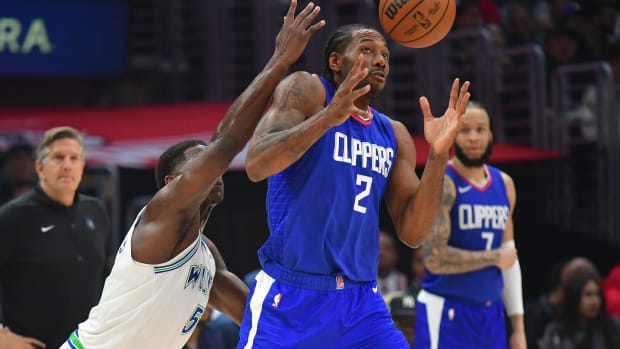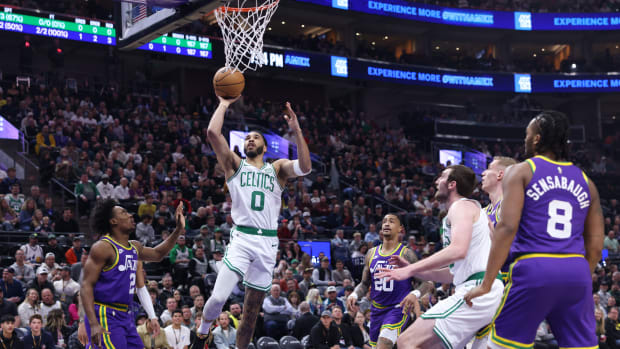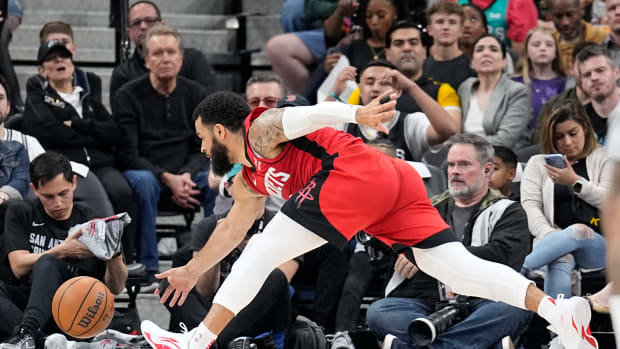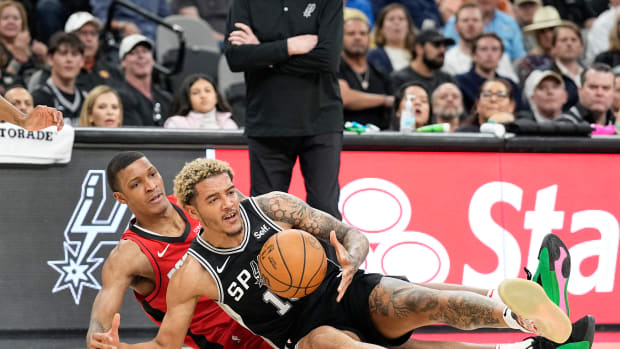SI:AM | Trae Young Had Another Great Villain Moment at MSG
Good morning, I’m Dan Gartland. I’m glad I don’t care about the Knicks as much as I once did.
If you’re reading this on SI.com, you can sign up to get this free newsletter in your inbox each weekday at SI.com/newsletters.
He loves being the bad guy
The Knicks are pretty much toast, and Trae Young is the reason why.
New York entered last night’s game against the Hawks four games behind Atlanta for 10th place in the East. If the Knicks wanted to make the play-in tournament, they really needed a win at home against the team currently occupying the last postseason spot.
Knicks fans should know by now how that was going to go. Atlanta won 117–111 behind 45 points from New York’s favorite villain, Trae Young.
Young first got under Knicks fans’ skin during last year’s playoffs, when he silenced a white-hot Madison Square Garden crowd with a game-winning floater in Game 1 of their series and then told them all to shush. After burying a three in the final seconds of Game 5 to eliminate the Knicks, Young took a bow.
He’s been the biggest sports villain in New York ever since. Fans at the Garden chanted “F--- Trae Young” during games against other teams. WWE even brought him out during a show at the Garden in September to get the crowd riled up.
The NBA leaned into New Yorkers’ hate for Young by scheduling the Hawks’ first visit to the Garden this season for the league’s big Christmas Day showcase. But Young missed that game because he was in the league’s health and safety protocols, so he was ready to make up for lost time last night—and so were Knicks fans.
The crowd booed Young every time he touched the ball early on, but Young quieted them with an offensive onslaught. He had 45 points on 13-of-25 shooting and eight assists. He scored a ridiculous layup as the buzzer sounded at the end of the first quarter and put Taj Gibson on the deck with a nasty crossover on his way to scoring a clutch bucket late in the fourth.
And Young embraced the villain role. He told a Knicks fan sitting courtside to “hold that L” and said after the game that he thought the crowd “wasn’t even that loud.”
But the best way to make a fan base mad at you is to win a big game, and Young and the Hawks did just that. The stakes may not have been nearly as high as a playoff series, but the loss was one of the final nails in the Knicks’ coffin. They’re now six games behind the Hawks for 10th in the East with only 10 games to play—not officially eliminated but effectively cooked.
Trae Young vs. the Knicks (and Knicks fans) could be one of the great NBA rivalries of the next decade. Young will be a superstar for many years to come and clearly enjoys taking his game to the next level at MSG, but will the Knicks ever present a real challenge for him? So far, it’s been a very one-sided rivalry.
The best of Sports Illustrated
In today’s Daily Cover, Brian Straus analyzes the challenge facing the USMNT in its final World Cup qualifying window.
Fielding your strongest lineup in Mexico City and trying to secure that additional point may leave vital players with tired legs ahead of the must-win showdown against Panama. But save your best XI for game No. 2 and you might still wind up needing a good result in Costa Rica, where Los Ticos probably will be playing for their World Cup lives.
Jon Wertheim explains why No. 1 tennis player Ash Barty’s retirement at 25 actually isn’t all that surprising. … Our experts remade their men’s brackets now that the Sweet 16 is set. … The final World Cup qualifying window will be a chance for Christian Pulisic to make his mark, Avi Creditor writes. … Jon Wertheim spoke with former tennis pro Alex Dolgopolov, who is now fighting to protect Ukraine from the Russian invasion. … We put together a gallery of some of SI’s best photos of female athletes for Women’s History Month.
Around the Sports World
Senator Bernie Sanders will introduce legislation to challenge MLB’s antitrust exemption. … MLB’s new universal DH rule reportedly includes a tweak that is appropriately being called the “Shohei Ohtani rule.” The new USFL will allow teams to attempt a three-point conversion. … Here’s what tennis players are saying about Ash Barty’s retirement.
SIQ
On this day in 1972, the Yankees signed a new 30-year lease with the city of New York to remain at Yankee Stadium in the Bronx after threatening to build a stadium in New Jersey. The agreement included plans to renovate the stadium for two years, requiring the Yankees to play their home games at Shea Stadium in ’74 and ’75. Where did the Giants, who had played their home games at Yankee Stadium, play during the renovations?
Check tomorrow’s newsletter for the answer.
Yesterday’s SIQ: How many rounds of voting did NFL owners need to elect Pete Rozelle commissioner in 1960?
Answer: 23. Rozelle (born Alvin Ray Rozelle, but nicknamed “Pete” by an uncle as a child) got his start in the NFL as the public relations director of the Rams in the early 1950s, left for a few years and returned as general manager in ’57.
When Rozelle’s predecessor, Bert Bell, died in 1959, the league’s owners were divided on who should replace him. Some favored Austin H. Gunsel, a former FBI agent who headed the NFL’s investigation department before being appointed interim commissioner in the wake of Bell’s death. Others liked Colts general manager Don Kellett or 49ers attorney Marshall Leahy.
The owners spent seven days in South Florida in January 1960 trying to decide on a new commissioner. Leahy was a leading candidate, supported by seven teams in early voting, but said he didn’t want to leave his native San Francisco to run the league from its Philadelphia-based headquarters. Owners voted over and over again but couldn’t reach the three-fourths majority needed to confirm a candidate. Eventually, Rozelle was floated as a compromise selection and confirmed on the 23rd ballot.
Rozelle went on to revolutionize the league, navigating through the AFL-NFL merger and negotiating its first billion-dollar TV contract in 1982 ($2.1 billion over five years).
From the Vault: March 22, 1976
Last week, I looked back at the March 15, 2004, issue of SI, in which Tom Verducci slammed MLB for failing to get a handle on steroid use as the BALCO scandal erupted. Six years earlier, Verducci wrote another cover story that portended the arrival of the steroid era. “A Farewell to Skinny Arms” was the headline, and the article chronicled how big muscles were all the rage ahead of the 1998 season.
Now, Verducci didn’t act like this sudden power surge was all natural. The story opens with an anecdote about the prevalence of creatine shakes.
“Every day this spring a battalion of protein drinks spiked with the muscle-enhancing supplement creatine awaited the New York Yankees after they ended their workouts in Tampa. The white Styrofoam cups with red straws poking through the lids were lined up on a table in the clubhouse like soldiers awaiting inspection. One afternoon, as his players snatched up all the cups, the most powerful of Yankees sucked on his shake while admonishing a clubhouse attendant. ‘Next time make sure you have a few more made up,’ said owner George Steinbrenner, dressed in his own uniform of blue blazer and white turtleneck. ‘Better to have too much than not enough.’”
That’s right. Even the 67-year-old Yankees owner was taking creatine, joining a long list of players that included everybody from Mike Piazza to aging singles hitter Wade Boggs. Of course, we now know that plenty of players were taking a lot more than over-the-counter supplements, but the impact stronger players had on the game was undeniable.
The central theme of Verducci’s article is that the 1998 season was poised to be a slugfest, but not only because of the “beefy, pumped-up maulers” mentioned in the subheadline. That season was when MLB expanded from 28 teams to 30 with the addition of the Diamondbacks and Rays, and Verducci correctly predicted that the watered-down quality of pitching would make things easier for hitters, just as it did in ’61 when the American League added two expansion teams and Roger Maris hit 61 home runs. Indeed, Mark McGwire and Sammy Sosa did surpass Maris’s 61 home runs that year, but it probably wasn’t because a few extra pitchers got promoted from the minors.
Check out more of SI’s archives and historic images at vault.si.com.































